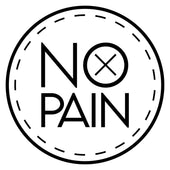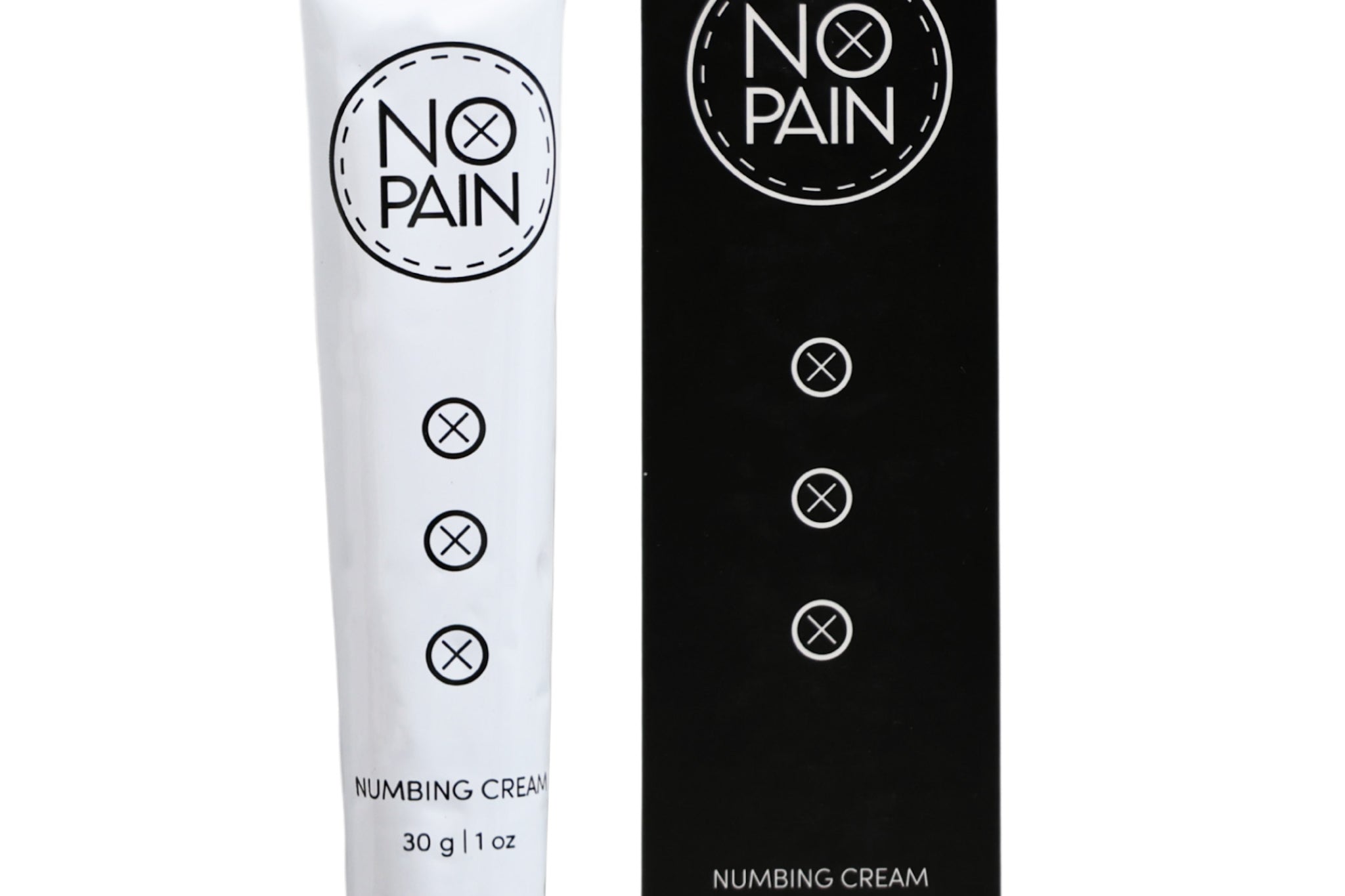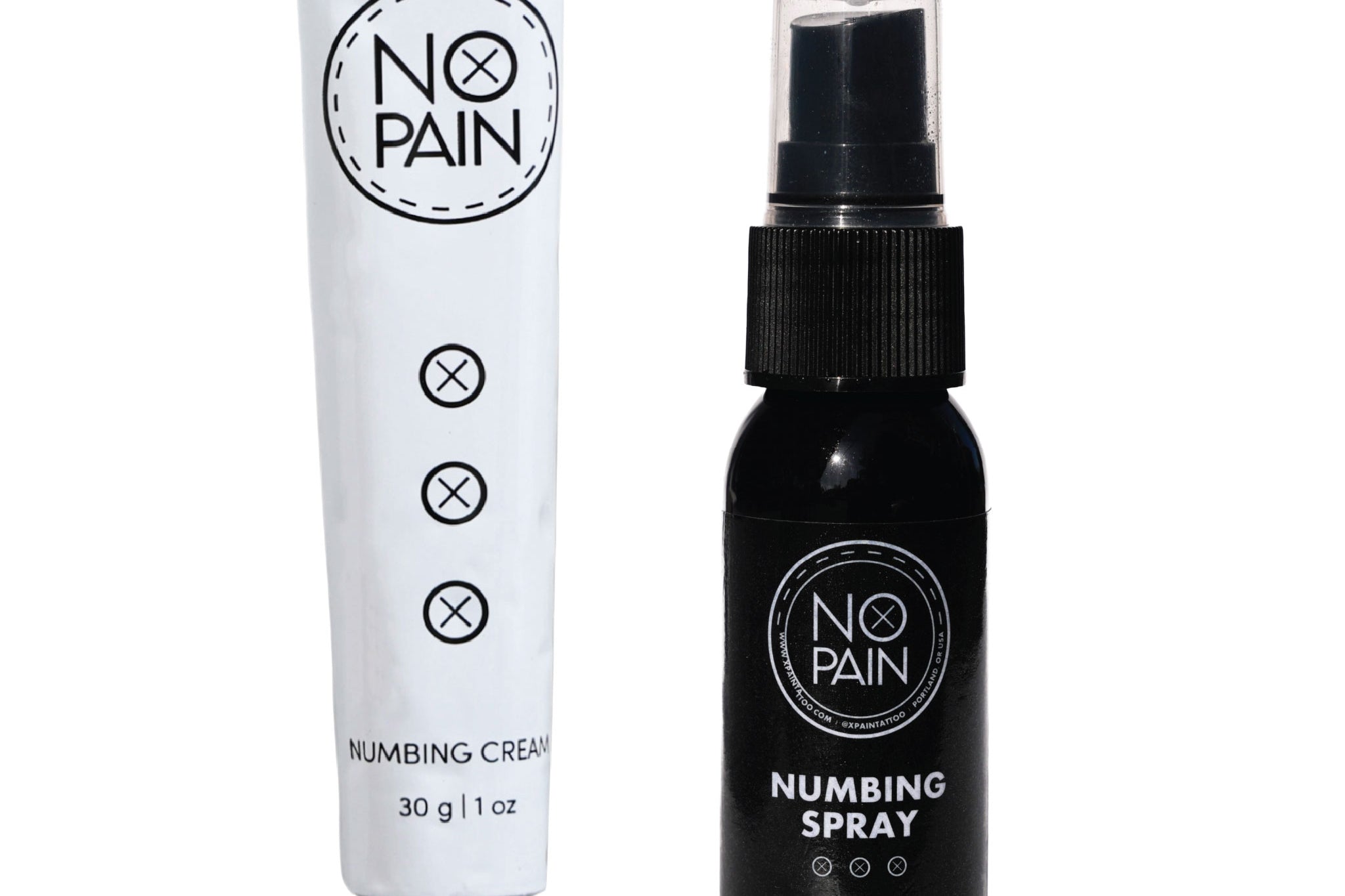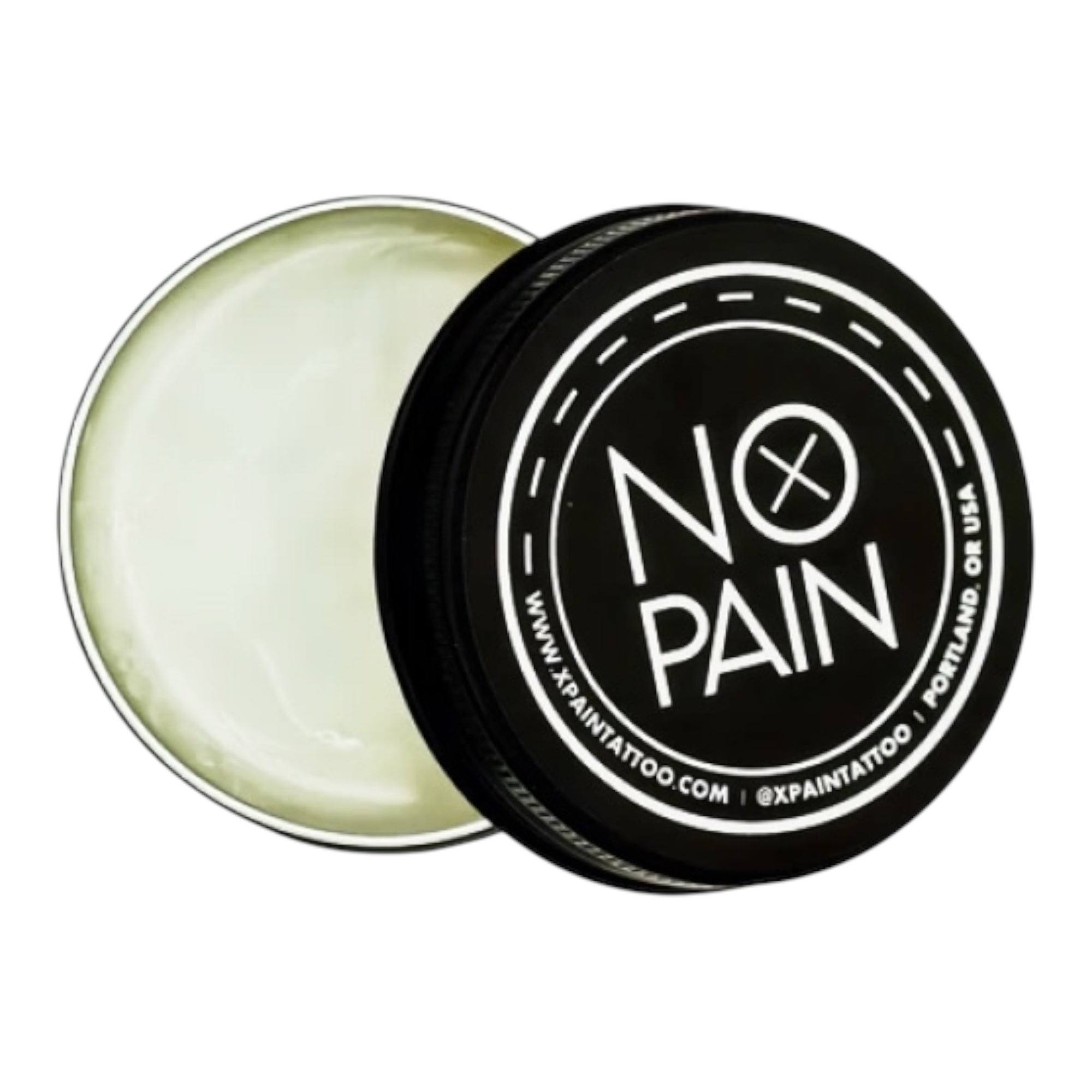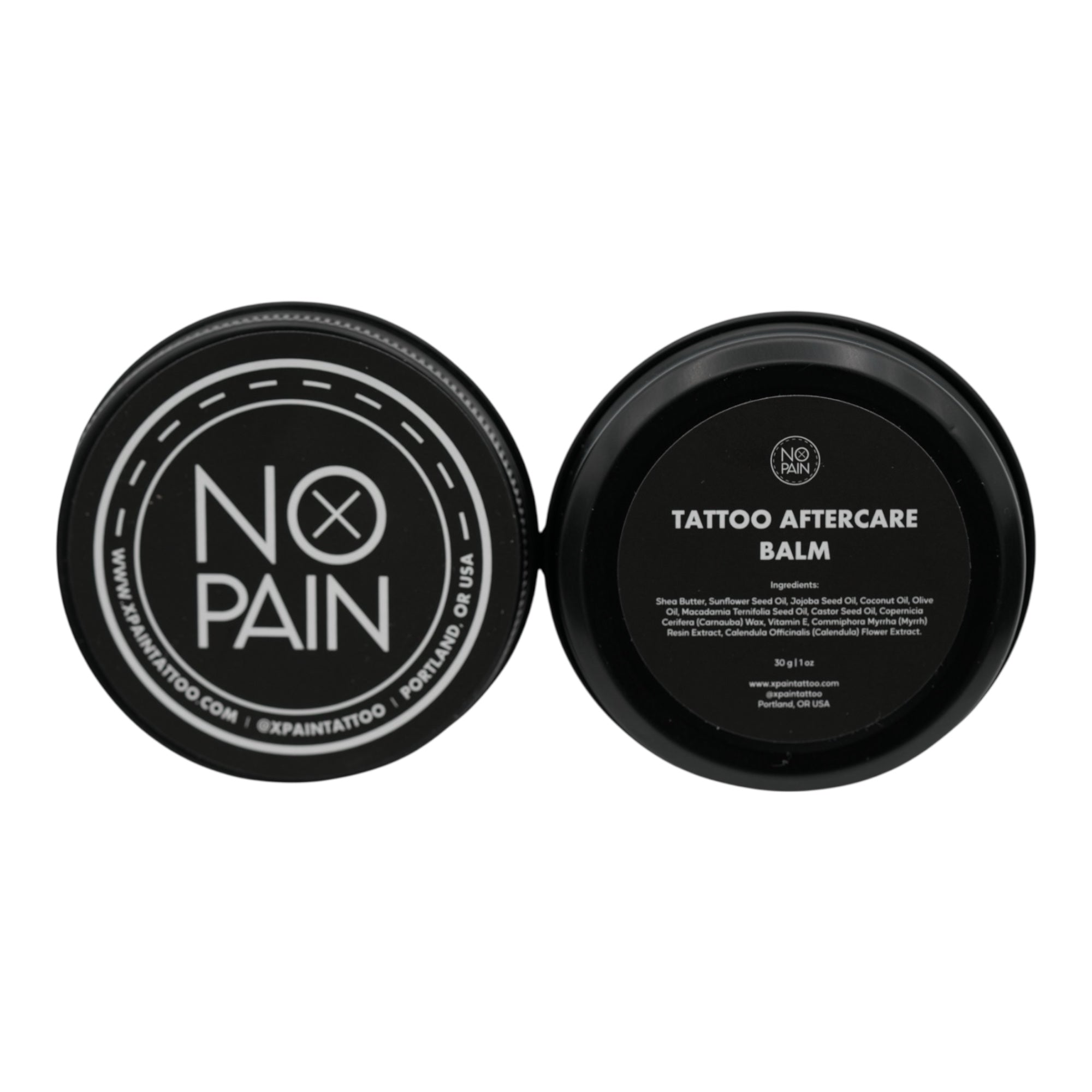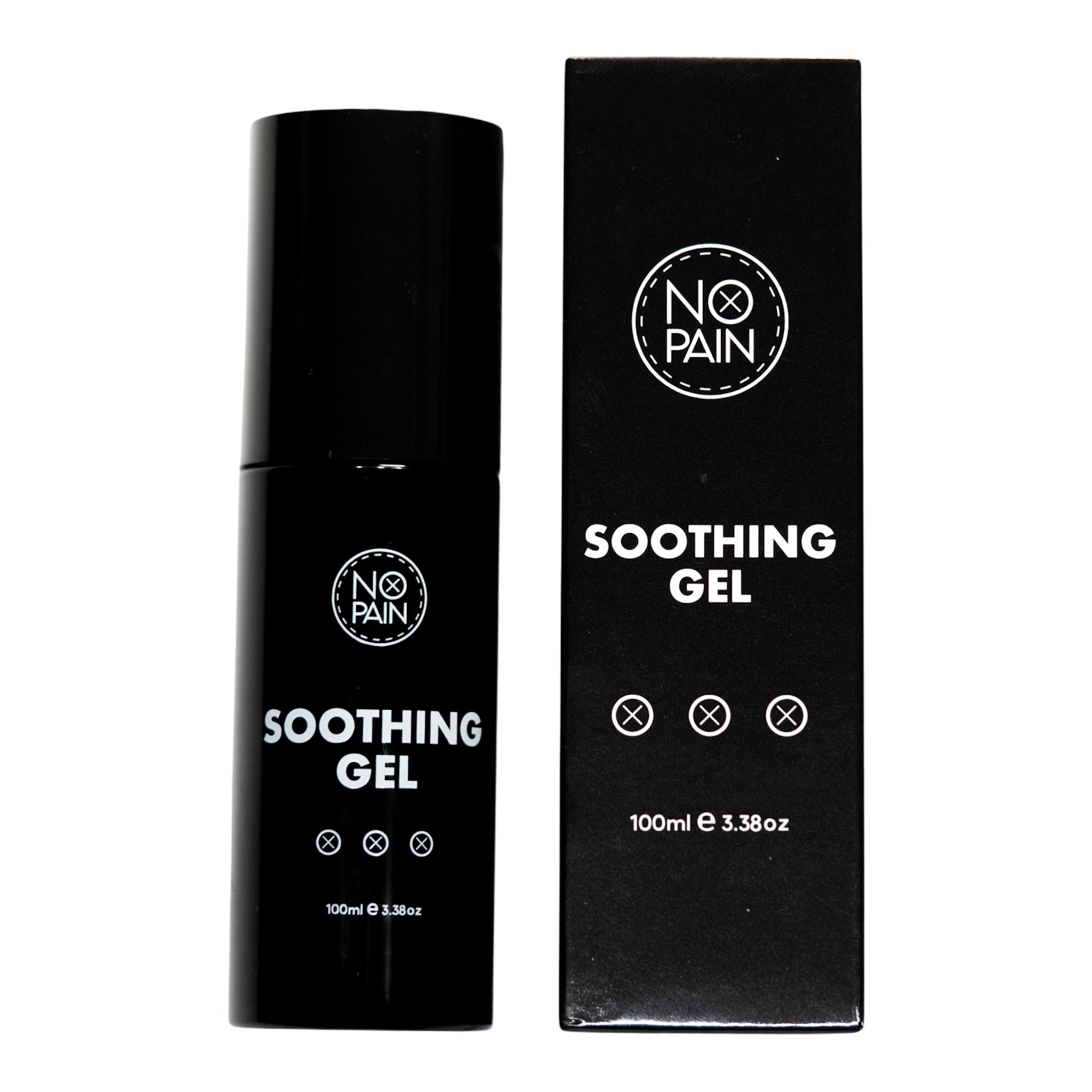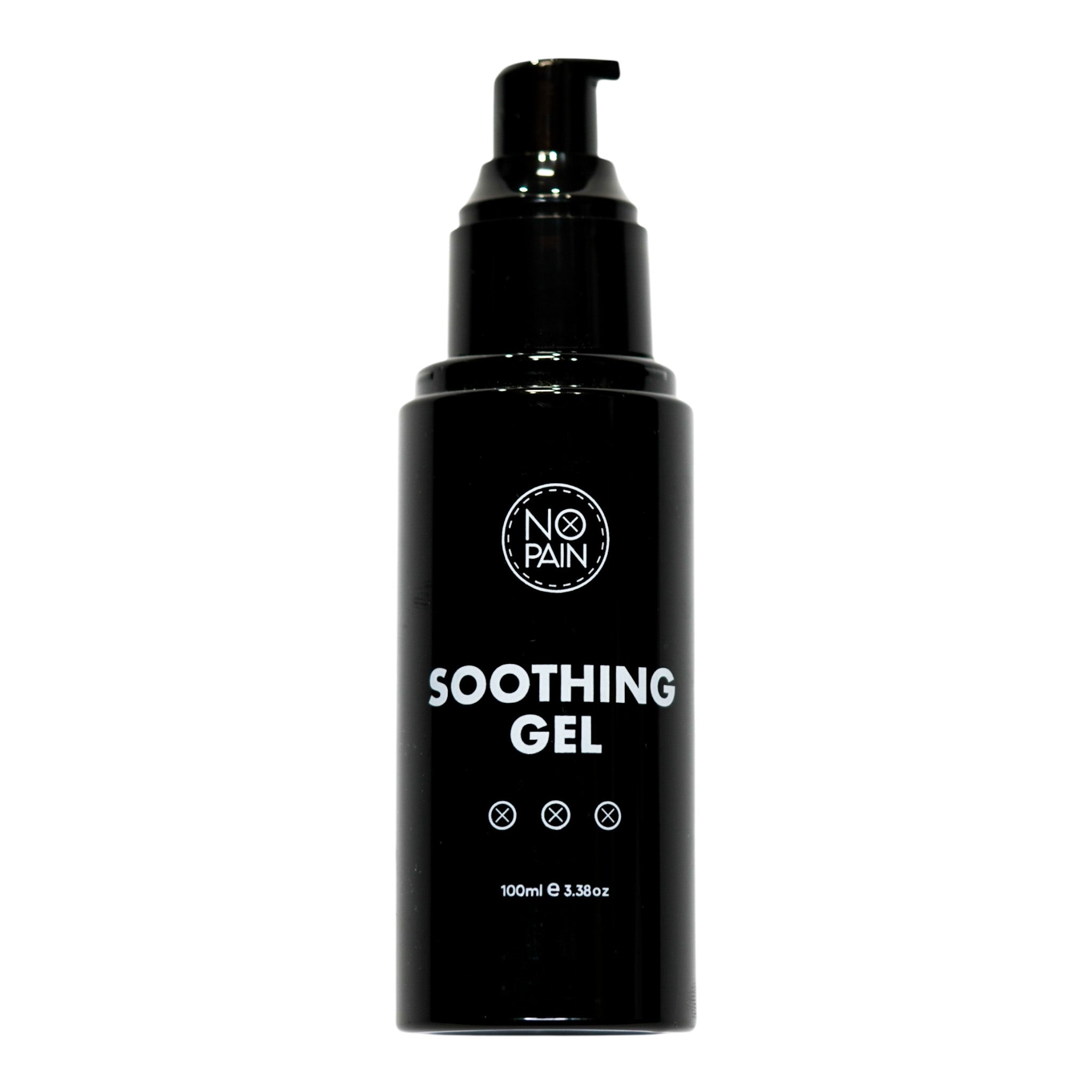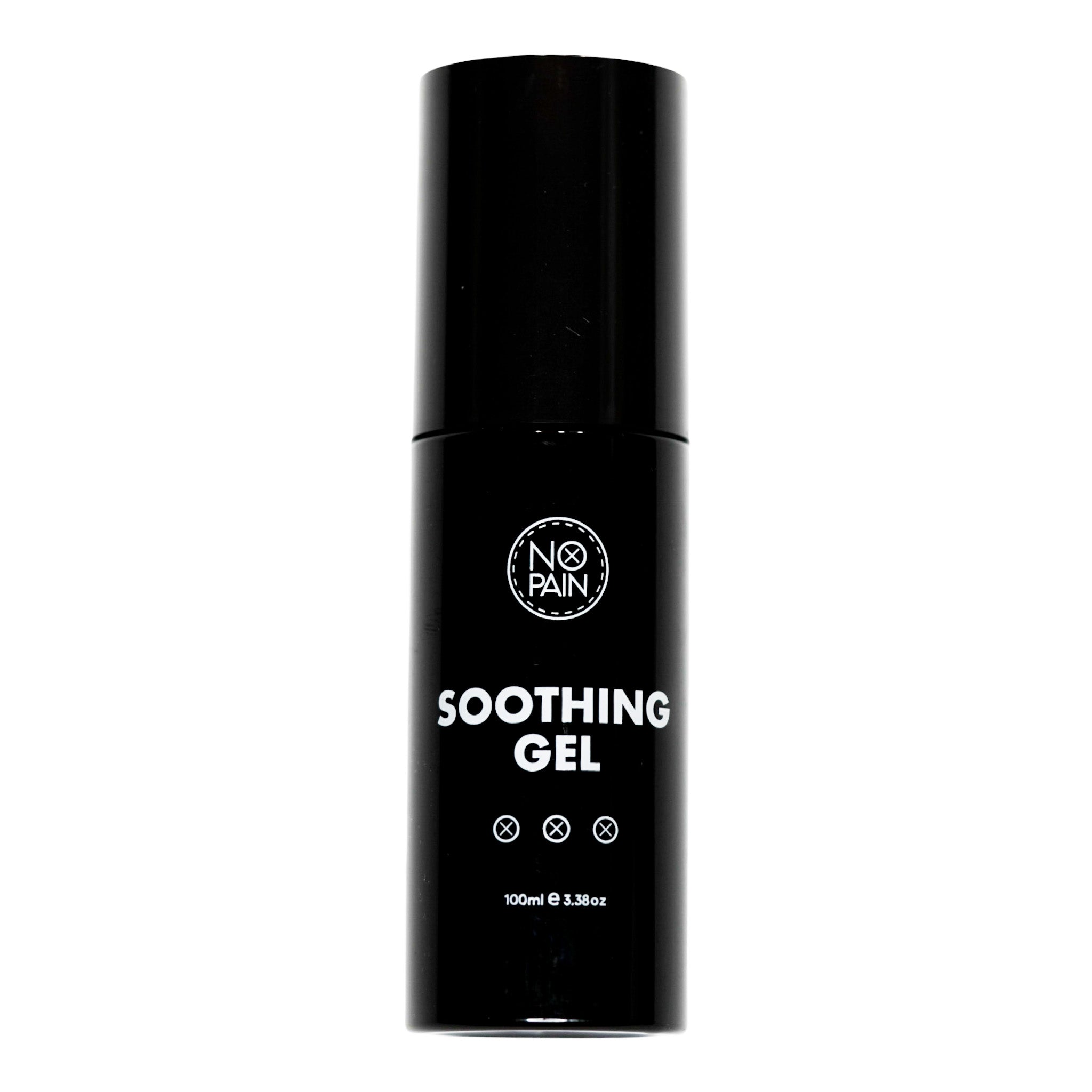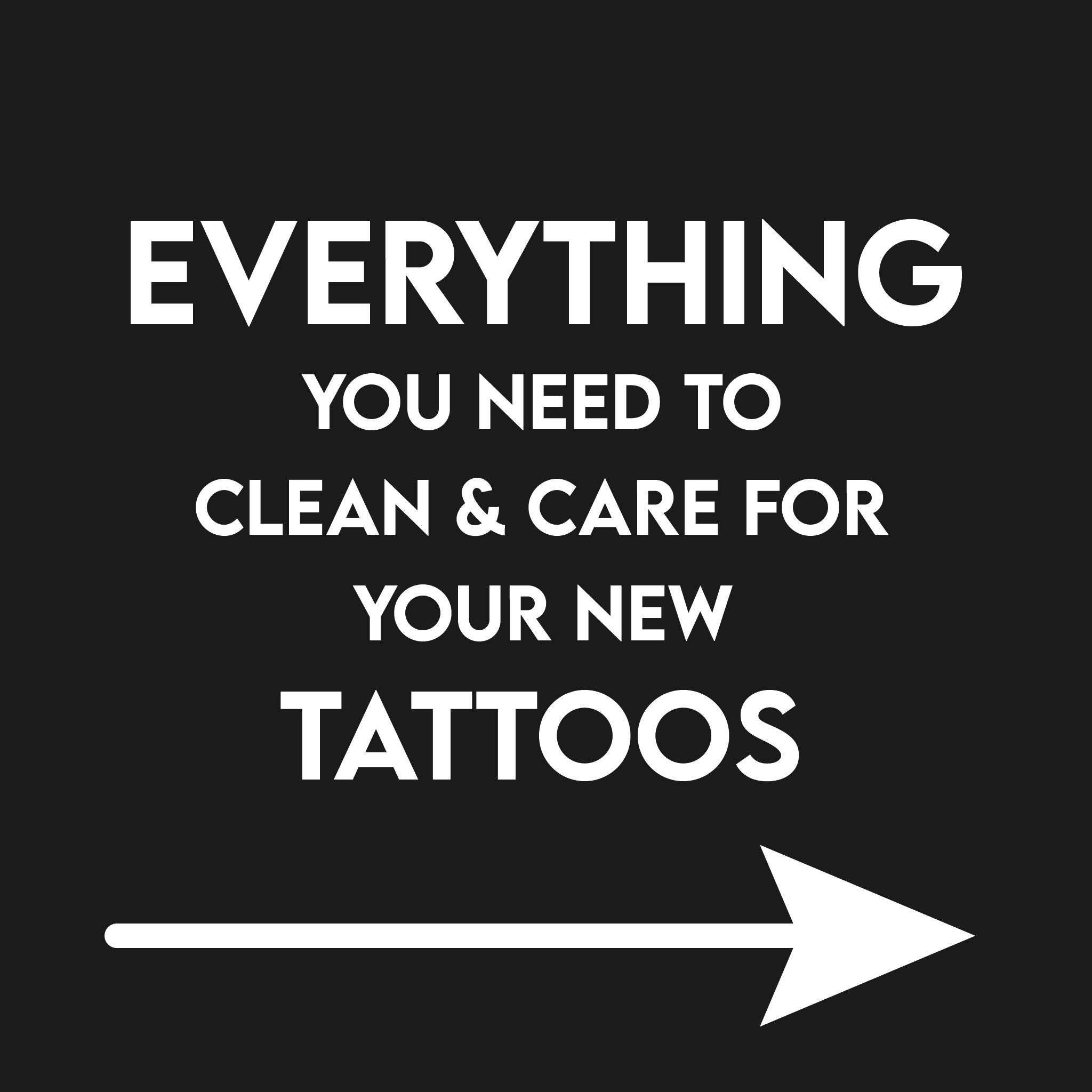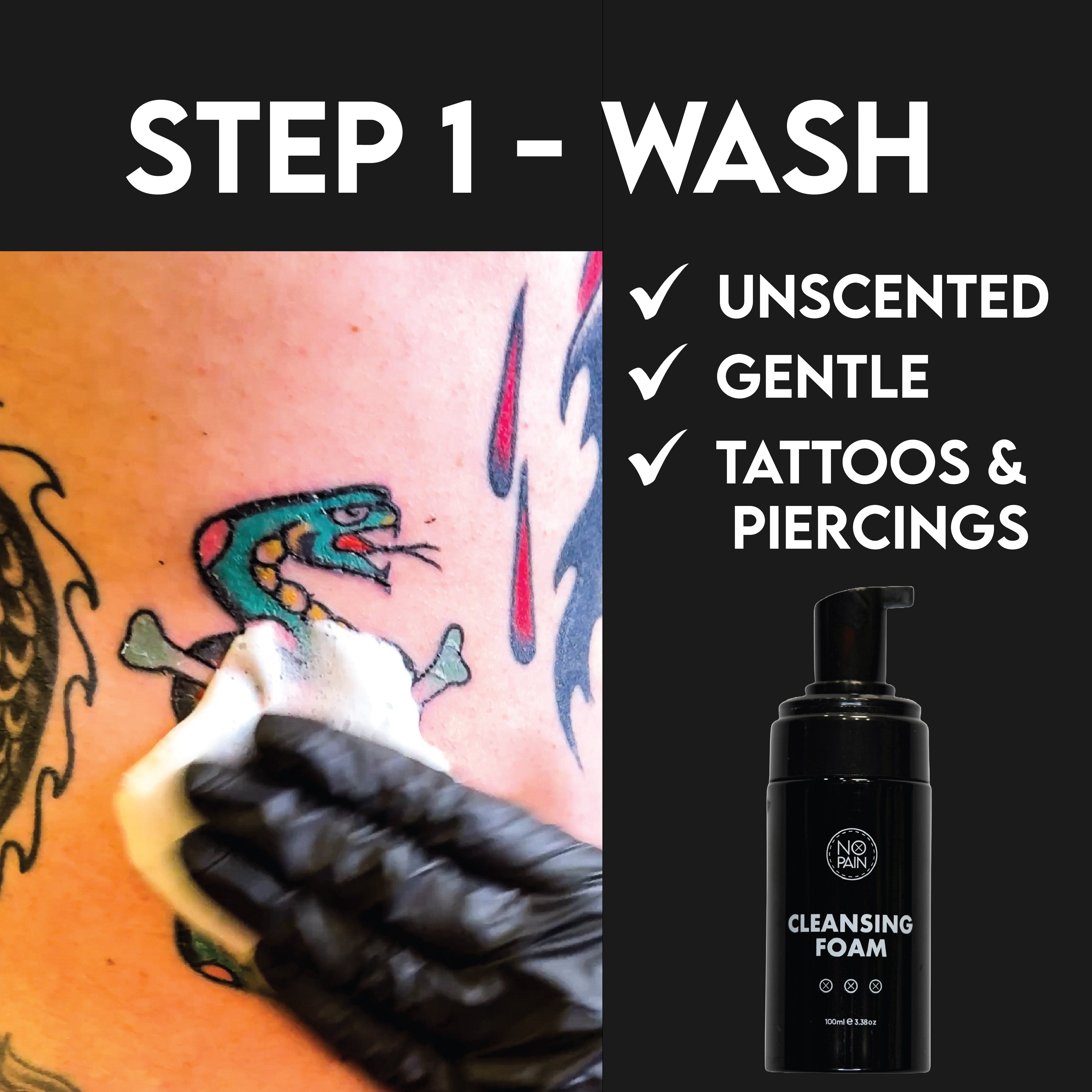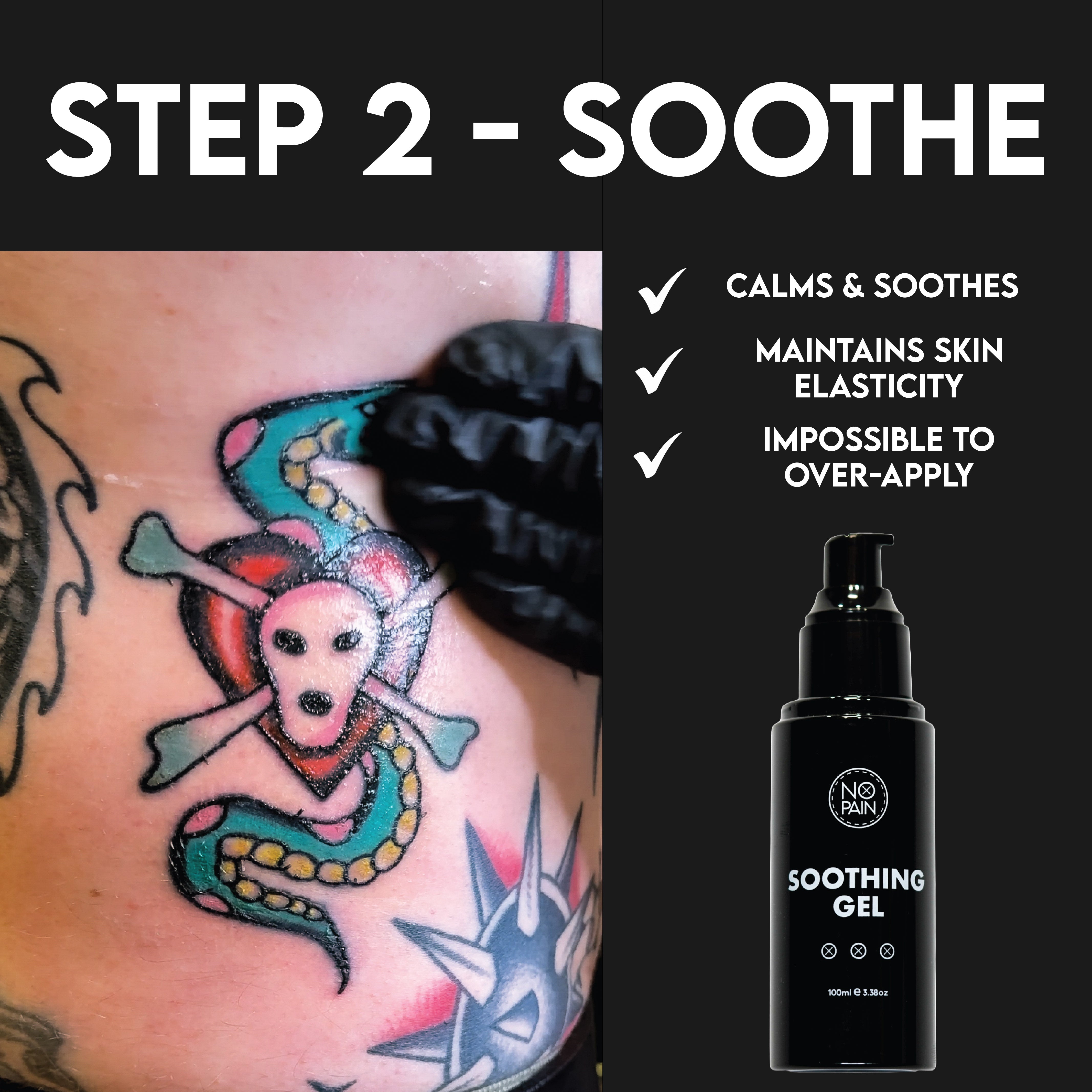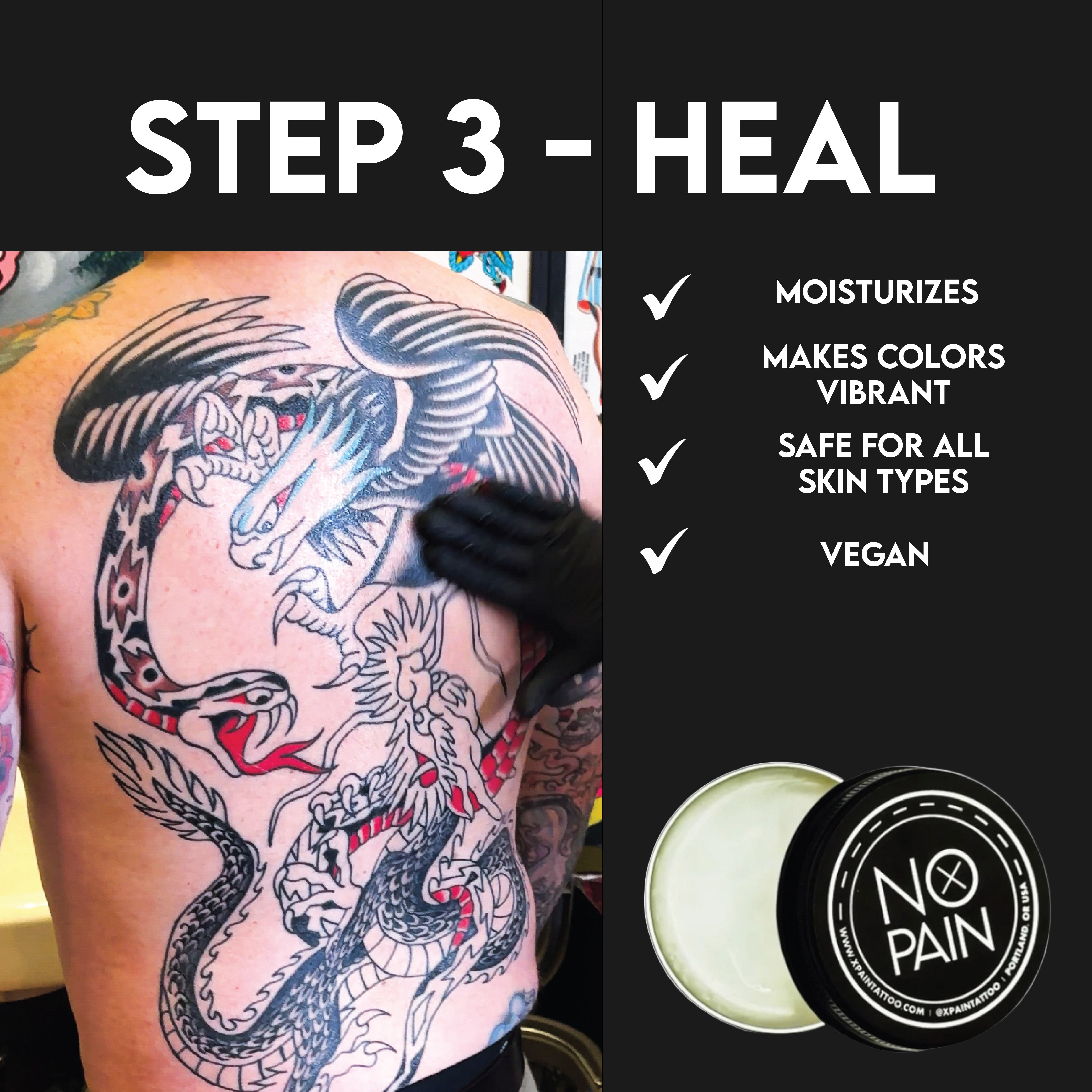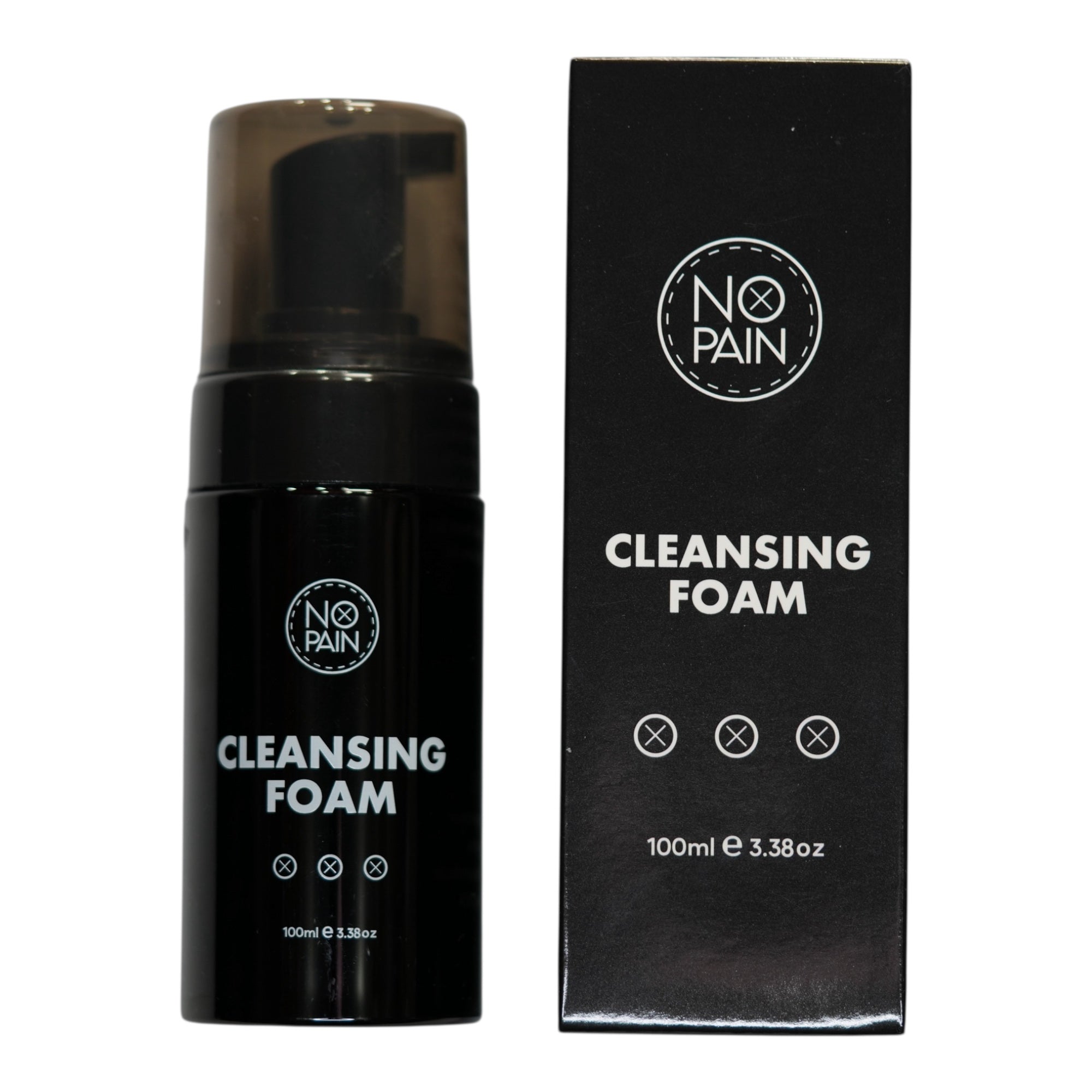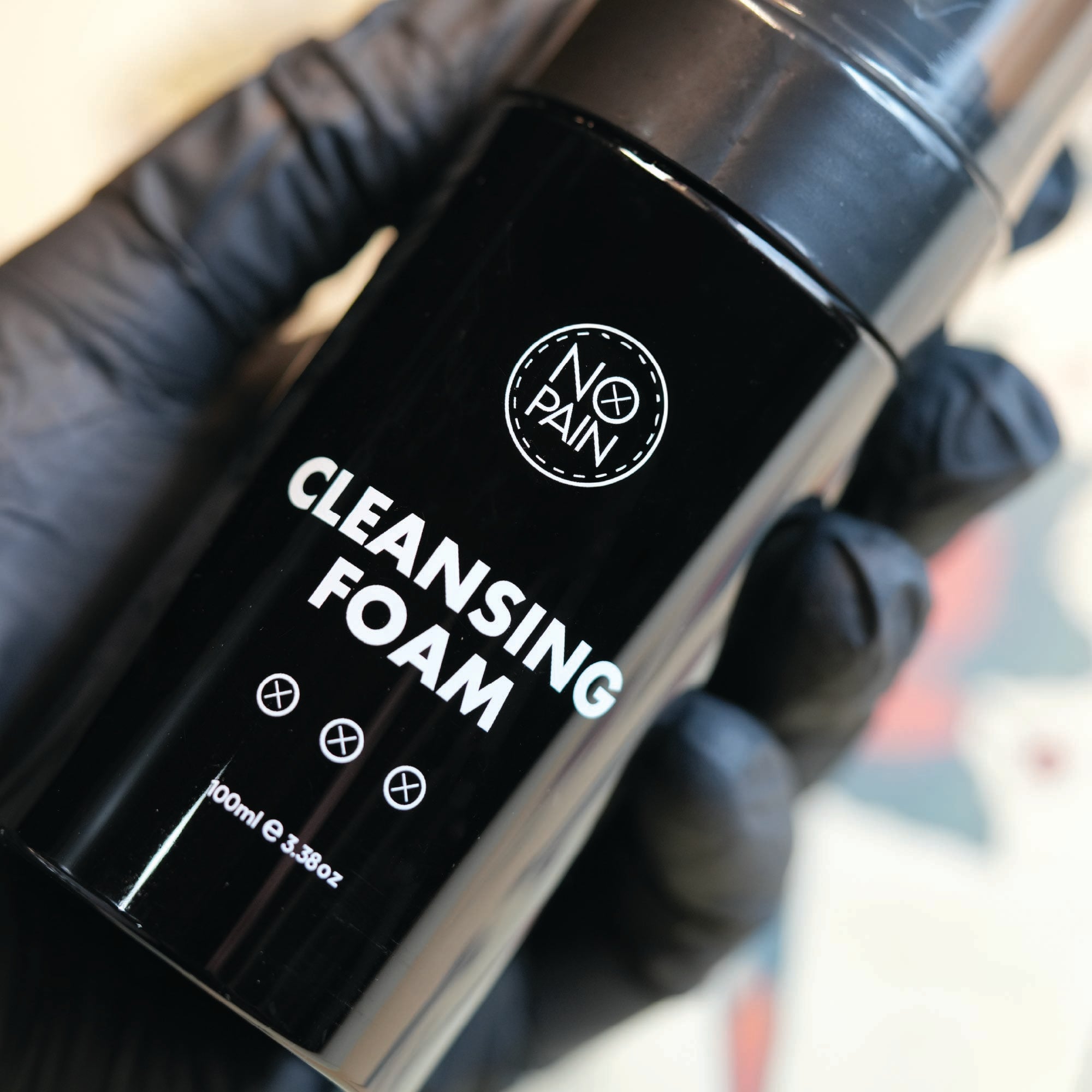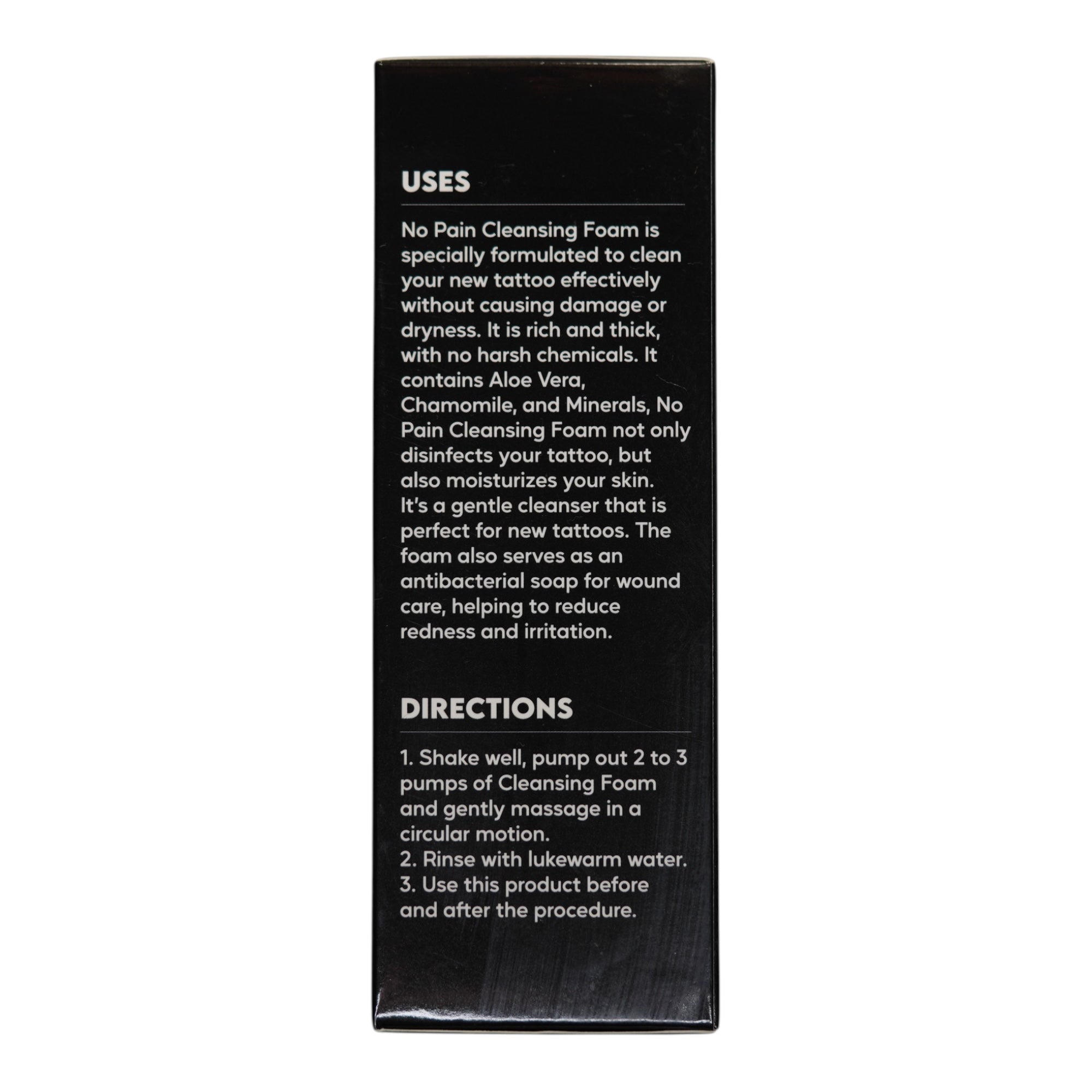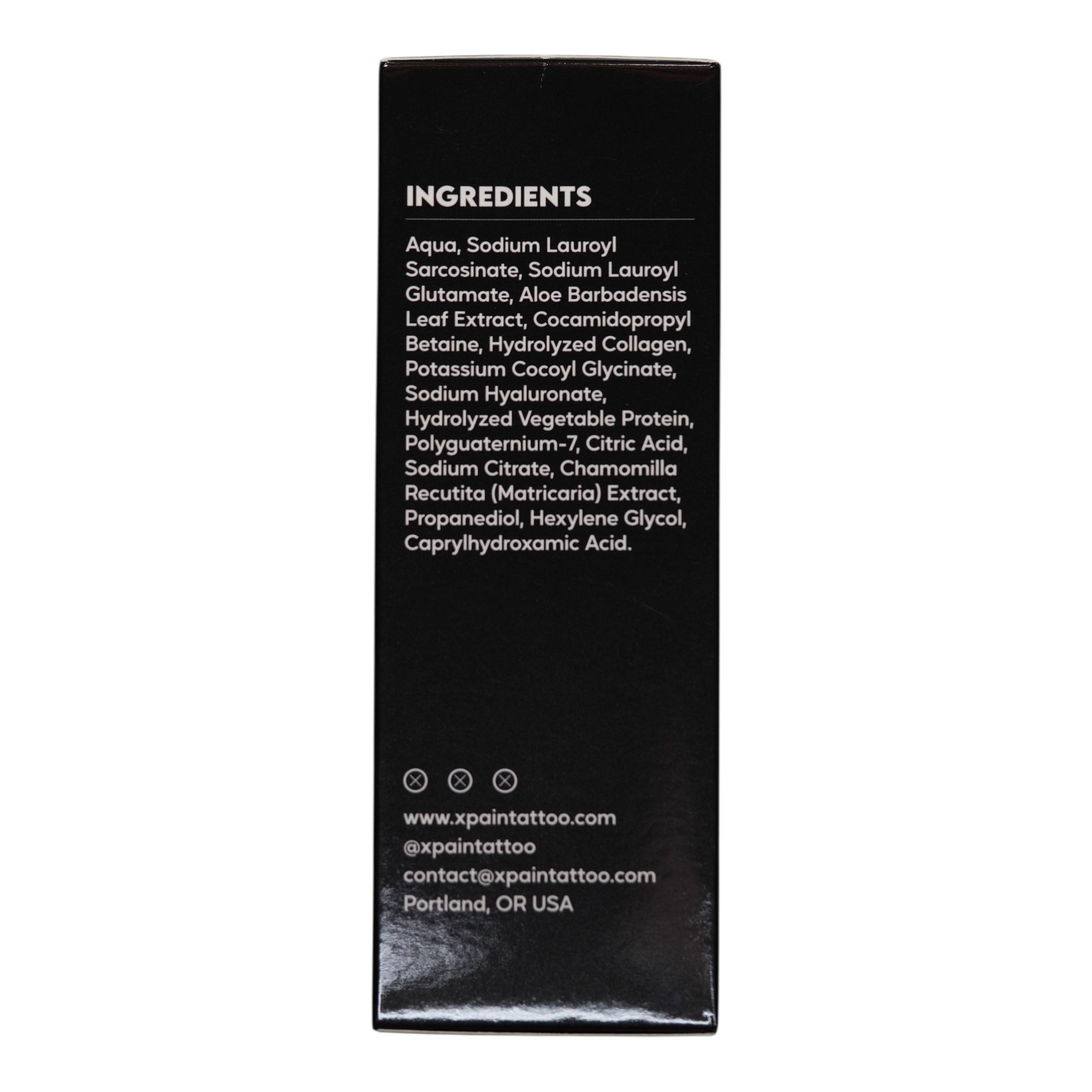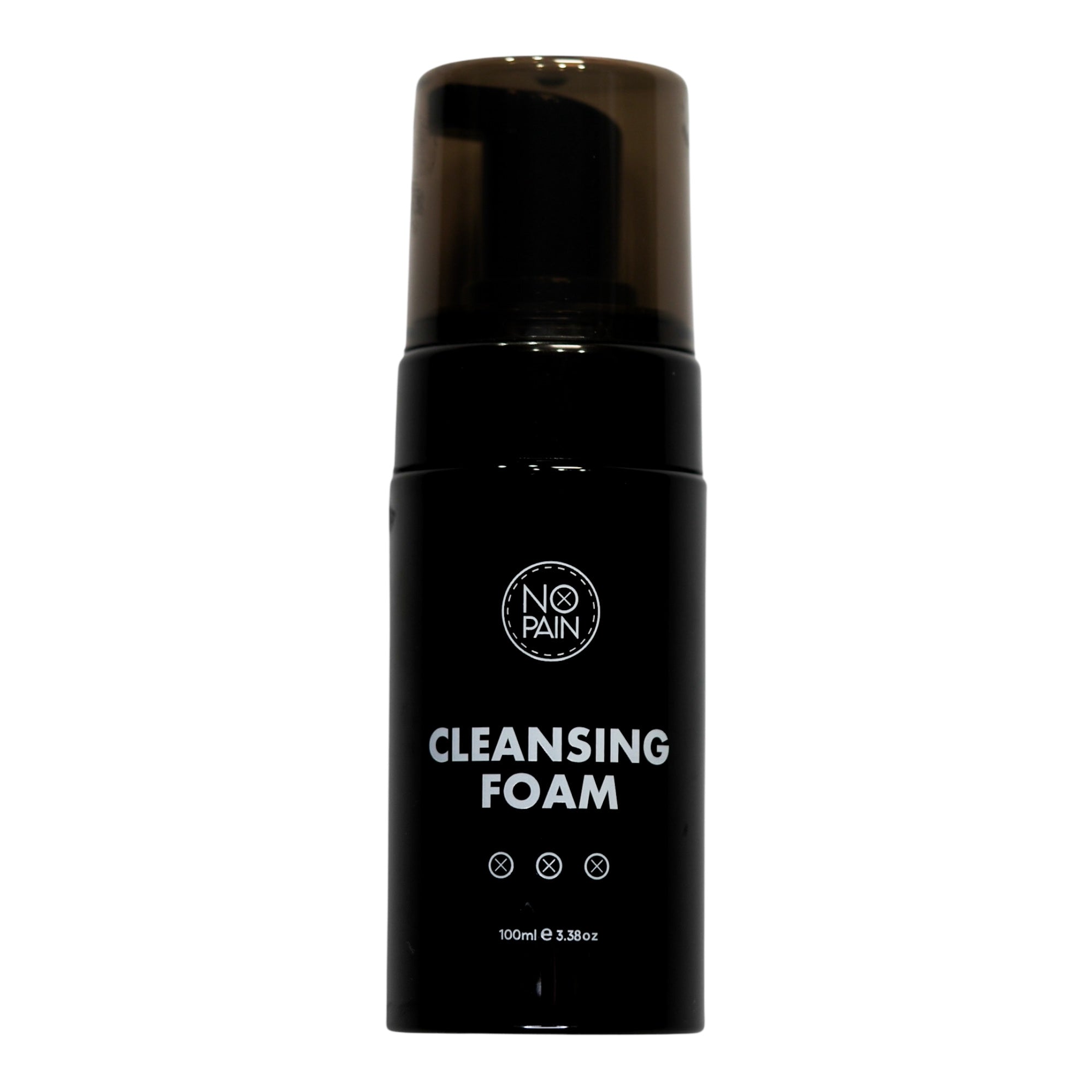Professional Tattoo Aftercare: The Complete Healing System
Getting the tattoo is only the first half of the journey. The tattoo healing stages are just as critical, and a flawless heal is what locks in your artist's work for a lifetime. Generic soaps and lotions aren't designed for the specific needs of a healing wound.
This collection contains our 3-step professional tattoo aftercare system, designed to work together to clean, soothe, and heal your new art, preventing infection and ensuring maximum vibrancy. (Learn the full routine in our Guide to Tattoo Aftercare: The First 48 Hours.)
Step 1: Cleanse The crucial first wash sets the stage. Our No Pain Tattoo Cleansing Foam is a gentle, antimicrobial, and hypoallergenic wash that effectively removes bacteria and plasma without irritating your tender skin.
Step 2: Soothe For the first few days, your tattoo will be red and inflamed. Our No Pain Tattoo Soothing Gel is a lightweight, water-based formula that provides instant cooling relief, calms irritation, and soothes the itch without clogging pores.
Step 3: Heal & Moisturize Once the peeling phase begins, our No Pain Tattoo Aftercare Balm is the perfect tool. This nutrient-rich, breathable balm provides deep hydration to prevent heavy scabbing, relieve itching, and keep your new tattoo vibrant.
Get the complete, artist-recommended solution in one package with our No Pain Tattoo Aftercare Bundle.
The Definitive Guide to Tattoo Aftercare: Protecting Your Investment for a Lifetime
Your Tattoo is a Partnership – From Artist to Aftercare
The journey of a tattoo begins long before the needle touches your skin – with a vision, a design, and the selection of a trusted tattoo artist. But the moment you leave the studio, the critical responsibility for the final outcome shifts squarely to you. A truly great tattoo is a 50/50 partnership: your artist masterfully applies a clean, technically flawless piece of art, and you are entrusted with the equally vital task of preserving and healing it.
The hours, days, and weeks following your session are not just a passive waiting period; they are an active, crucial phase that will dictate the vibrancy, clarity, and longevity of your new body art. However, the method in which you meticulously navigate the intricate tattoo healing stages will determine whether your investment remains a vibrant, flawless masterpiece, or succumbs to fading, patchiness, or—in the worst-case scenario—infection.
This comprehensive guide is meticulously crafted to be your ultimate resource for tattoo aftercare. We will delve into every critical phase, from the immediate post-session hours to the long-term maintenance required for a lifetime of brilliance. We’ll dissect common misconceptions, scientifically debunk popular myths surrounding products like Aquaphor and Vaseline, clarify the nuanced differences between specialized balms, lotions, and ointments, and provide a detailed, step-by-step roadmap for achieving a perfect, vibrant heal. Consider this your definitive manual for protecting your inked investment.
Part 1: The Immediate Aftermath – The Critical First 48 Hours
The first two days post-tattoo are not merely important; they are absolutely critical. This initial period sets the indispensable foundation for the entire subsequent healing process. Missteps here can lead to irreversible damage, while diligent care ensures optimal results.
Step 1: The Initial Protective Wrap – Following Your Artist's Wisdom
Upon completion of your tattoo, your artist will apply a protective covering. This initial wrap is far more than a simple aesthetic gesture; it serves as a sterile barrier, safeguarding your freshly open wound from a myriad of environmental threats including airborne bacteria, dust, dirt, and friction from clothing or accidental bumps.
The duration this wrap should remain on is entirely dependent on its type:
- Traditional Plastic Wrap (Cling Film): If your artist uses standard cling film, it’s typically recommended to keep it on for a short period, generally 2 to 4 hours. This temporary shield is crucial for the journey home but should be removed promptly to allow the wound to breathe and begin its cleaning process. Leaving non-breathable plastic on for too long can trap moisture and create an ideal breeding ground for bacteria.
- Absorbent Surgical Dressing (Pad & Tape): A classic method, particularly favored by artists with a more traditional approach, involves covering the fresh tattoo with a sterile, highly absorbent medical pad, secured firmly with tape. This dressing is designed for a slightly longer initial application, typically overnight or for around 10-12 hours. This period effectively manages the tattoo’s heaviest weeping phase within a protected environment, preventing adhesion to bedding and providing a secure shield during sleep.
- Advanced Adhesive Bandages (e.g., Saniderm, Tegaderm): Many modern artists opt for specialized, breathable, medical-grade adhesive films. These "second skin" bandages are revolutionary, providing an active barrier that protects while allowing oxygen exchange. These can often remain on for 3 to 5 days, and sometimes even up to a week. It's common and normal to see a "soup" of plasma and ink collect beneath these wraps; this is part of the moist healing environment they create.
Crucial Directive: Regardless of the wrap type, your paramount instruction is to listen to your artist's specific guidance. They choose their wrapping method based on their technique, the tattoo’s size, placement, and their experience with optimal healing outcomes. (For an in-depth exploration of different bandage types, consult our guide: How Long Should You Leave Your New Tattoo Wrapped?).
Step 2: The First Wash – A Critical Cleansing Protocol
This step can be intimidating if it’s your first time, but it’s an easy and necessary part of your initial tattoo aftercare routine. Once you’ve washed your hands, and carefully removed the initial wrap, your immediate task is to gently but thoroughly wash your new tattoo.
The Goal: The primary purpose of this inaugural wash is to meticulously remove the "weep." This weep is a natural exudate—a mixture of plasma, lymph fluid, residual excess ink, and sometimes a tiny bit of blood—that accumulates beneath the bandage. If this weep is allowed to dry on the skin, it will inevitably solidify into thick, heavy scabs. These heavy scabs are the absolute number one enemy of a smooth, vibrant heal, posing a significant risk for ink loss and scarring. (To understand this process further, read our in-depth article: Guide to Tattoo Weeping).
The Precise Method:
- Impeccable Hand Hygiene: Before even considering touching your fresh tattoo, wash your hands meticulously with antibacterial soap for at least 20 seconds. This prevents the transfer of harmful bacteria to your open wound.
- The Right Cleanser is the Incredibly Important: Do NOT reach for a harsh bar of soap, a heavily fragranced body wash, or any product not specifically designed for tattoo aftercare. These can strip the skin's natural moisture barrier, introduce irritants, and impede healing. You require a gentle, antimicrobial, pH-balanced, and hypoallergenic cleanser. Our No Pain Tattoo Cleansing Foam is precisely formulated for this delicate task. Its dye-free, non-stinging, and easy-to-apply foam effectively cleanses the wound without causing any irritation or needing aggressive scrubbing.
- Gentle Washing Technique: Using only the pads of your clean fingertips, apply the foam directly to the tattoo. With light, circular motions, gently wash the entire tattooed area with lukewarm (never hot) water. The goal is to encourage the weep to loosen and rinse away, not to scrub or abrade the delicate skin. Take your time with this step.
- Thorough Rinsing: Allow a steady stream of lukewarm water to run over the tattoo until all traces of the cleansing foam and the slimy plasma are completely gone. Ensure no residue remains.
- Pat, Do Not Wipe: Resist the urge to wipe the tattoo with a cloth towel, which can harbor bacteria and be abrasive. Instead, use a fresh, clean, disposable paper towel to gently pat the area completely dry. Then, allow it to air dry for an additional 5-10 minutes. This ensures no residual moisture remains to promote bacterial growth.
Step 3: Managing Early Inflammation – Soothe, Don't Suffocate
Immediately after that crucial first wash, your tattoo transitions into an open, actively healing wound. It is completely normal and expected to experience a range of sensations:
- Redness and Inflammation: The tattooed area will exhibit noticeable redness, swelling, and feel warm to the touch. This is your body's natural inflammatory response to trauma and a healthy sign of initial healing. (If the area appears excessively raised or bumpy, it's typically this initial swelling, not a cause for alarm).
- Continued Weeping: Your tattoo will likely continue to express a clear or slightly ink-tinged fluid (plasma) for the first 24-48 hours. This is normal and a sign your body is cleaning the wound.
- Soreness: The area will feel akin to a fresh, tender sunburn. This sore tattoo sensation is perfectly normal and expected.
The Solution: This is not the stage for heavy, occlusive balms or thick lotions. Your delicate skin needs to be kept clean, allowed to breathe, and its inflammatory response gently calmed to facilitate wound closure. This is the perfect stage for our No Pain Tattoo Soothing Gel.
It’s a lightweight, water-based gel, specifically designed for application during these critical first few days. It delivers instant cooling relief, effectively calms redness and inflammation, and soothes the skin without the risk of clogging pores or trapping the vital plasma needed for early healing. Apply a thin layer 2-3 times daily as needed.
Red Flags: What to Watch For:
A normal healing tattoo should show daily improvement, not worsening symptoms. While the above symptoms are normal, be vigilant for signs of a tattoo infection:
- Worsening Pain: If the tattoo becomes more painful after the second day, especially if accompanied by throbbing.
- Spreading Redness: Dark red streaks radiating outwards from the tattoo.
- Pus: A thick, opaque yellow or green discharge (do not confuse this with normal, clear, or slightly tinted plasma).
- Fever/Malaise: If you feel generally unwell, have a fever, or experience chills, seek medical attention immediately.
Always trust your instincts and, if in doubt, consult your artist or a healthcare professional.
Part 2: The Product Showdown – What Should You Use for Optimal Healing?
The market is saturated with skincare products, making the selection for tattoo aftercare confusing. Understanding the fundamental differences between product types is crucial for making an informed choice that truly benefits your new ink.
Contender 1: Petroleum Jelly (Vaseline) & Occlusive Ointments (Aquaphor, A+D)
For many decades, these were the ubiquitous recommendations from both artists and casual tattoo enthusiasts. However, modern tattoo science and dermatological understanding highlight their significant drawbacks for healing tattoos.
- What They Are: Primarily petroleum-based (e.g., Vaseline is 100% petrolatum; Aquaphor is 41% petrolatum with mineral oil and lanolin). They are designed as highly effective occlusives.
- The Problematic "Seal": Their primary function is to create a thick, impenetrable, non-breathable barrier over the skin. While this can protect minor scrapes or chapped lips, a new tattoo is a large, complex open wound that desperately needs to breathe to heal properly. This heavy, airtight seal can suffocate the wound, trapping essential moisture, plasma, and heat against the skin. This creates a warm, moist, low-oxygen environment – a perfect breeding ground for anaerobic bacteria, significantly increasing the risk of infection and leading to a "bubbling" or waterlogged appearance of the skin.
- The Breakout Issue: The thick, greasy nature of petroleum jelly is notorious for clogging pores. This often leads to frustrating clusters of small, whitehead-style pimples (known as milia) or a painful rash on and around the healing tattoo. Our founder knows this firsthand; his personal struggle with these very breakouts when using petroleum-based products was the direct catalyst for developing a superior alternative.
- Passive Protection, Not Active Healing: These ointments act as a passive shield. They do not contain active ingredients, vitamins, or natural compounds specifically designed to actively nourish, regenerate, or support the complex cellular processes of healing tattooed skin. They merely sit on the surface.
- The Verdict: While the myth that Aquaphor pulls ink out is false, it is an outdated, suboptimal choice for new tattoos. It does not provide the ideal environment for a clean, vibrant heal and carries risks of breakouts and slowed healing.
Contender 2: Standard Drugstore Lotions
- What They Are: Typically thin, water-based emulsions, with water as the primary ingredient, combined with a smaller percentage of oils and various additives.
- The Problems for Tattoos: This list is extensive. Most commercial lotions are laden with harsh fragrances, dyes, alcohols, and synthetic chemicals. These are potent irritants that can cause severe stinging, allergic reactions, excessive redness, and dry out a fresh, open wound. Their high water content also means they offer very fleeting moisture and critically lack the protective barrier necessary to shield a healing wound from environmental friction and contaminants.
- The Verdict: A highly risky choice for a new tattoo. They offer inadequate protection, can introduce harmful irritants, and are best avoided entirely during the healing phase.
The Undisputed Winner: The Specialized Tattoo Balm
A modern, purpose-built tattoo balm represents the pinnacle of aftercare science. It is meticulously engineered to address all the unique needs of healing tattooed skin, offering the best of all worlds without the inherent drawbacks of generic products.
- What It Is: A specialized tattoo balm is a water-free formula, built upon a nourishing base of natural butters (such as shea or mango), waxes (like candelilla or beeswax), and a rich blend of nutrient-dense oils (e.g., coconut, jojoba, or vitamin E oil).
- Protective Yet Breathable: Like an ointment, it creates a crucial protective barrier against external friction, bacteria, and contaminants. Crucially, however, unlike an occlusive ointment, a high-quality balm is inherently breathable. This allows essential oxygen to reach your skin, which is absolutely vital for efficient cellular regeneration and a clean, healthy heal.
- Deeply Nourishing & Actively Healing: Unlike watery lotions, a balm delivers a concentrated dose of essential vitamins (A, D, E), fatty acids, and antioxidants directly to the skin. These ingredients actively nourish the skin, support robust cell regeneration, reduce inflammation, and help to lock in your new ink, promoting a more vibrant and stable long-term result.
- Specifically Formulated for Tattoos: This is the game-changer. A product like our No Pain Tattoo Aftercare Balm is developed from the ground up to be completely free of the irritants found in lotions and the suffocating petroleum of ointments. It is hypoallergenic, non-comedogenic (meaning it will not clog pores), and designed with the singular, unwavering purpose of healing and preserving the art that is your new tattoo.
- The Verdict: The clear, scientifically superior choice. A dedicated tattoo balm provides the ideal balance of breathable protection and nourishing moisture, all while being free from common irritants and pore-clogging agents.
Part 3: The Day-to-Day Healing Routine (Weeks 1-3)
As your tattoo transitions past the initial inflammation, it will enter the active healing phase, characterized by peeling, flaking, and itching. Your aftercare routine shifts from primarily "calming" to consistently "nourishing" and protecting.
- Consistent Cleansing: Maintain a diligent cleaning schedule. Gently wash the tattoo morning and night, and ideally once midday, using your Cleansing Foam. This is paramount to prevent bacterial buildup and manage any residual weep. Always wash with clean hands and lukewarm water, then pat dry with a paper towel.
- Strategic Moisturizing: Once the skin begins to feel dry and tight (typically after the first 3-5 days of using the Soothing Gel), transition to applying a thin, even layer of your Aftercare Balm. Apply 2-3 times a day, always after washing and air-drying. The goal is to keep the skin supple and moisturized, preventing heavy, brittle scabs from forming. A light, flaky peel is ideal; heavy scabbing is a sign of insufficient moisture or excessive plasma drying.
- Understanding Normal Healing Phenomena:
- Peeling and Flaking: This is completely normal and expected. The top layer of your epidermis, which was damaged during tattooing, is shedding to reveal the new skin underneath. Do not pick or force the peeling skin.
- Itching: The maddening itch is a hallmark of the healing process. It's a sign of new skin regeneration. Resist the urge to scratch! This can pull out ink and cause scarring. Gently pat the area or apply a little more Soothing Gel for relief.
- "Silver Skin" or Cloudiness: After peeling, your tattoo may appear dull, cloudy, or slightly shiny. This is called "silver skin"—a thin, new layer of skin that is still maturing. The true vibrancy of your tattoo will emerge as this layer fully settles, typically over several weeks.
- Why Do Some Tattoos Scab More Than Others? The amount of scabbing is influenced by artist technique, tattoo style (heavy color packing vs. fine line), placement (joints vs. fleshy areas), and most importantly, your aftercare. Proper moisturizing helps minimize heavy scabs.
Part 4: The 5 Most Damaging Aftercare Mistakes to Avoid
Even with the best products at your disposal, certain common habits can severely compromise your tattoo's healing and long-term appearance. These mistakes can lead to fading, patchiness, infection, or permanent scarring.
- Picking, Scratching, or Peeling Scabs: This is the absolute cardinal sin of tattoo aftercare. Those flakes and light scabs are intricately attached to the new, delicate skin where your precious ink is settling. Ripping them off prematurely will physically pull the ink out of your dermis, resulting in permanent patchy, faded areas and potential scarring.
- The Solution: When the maddening itch becomes unbearable, do not scratch. Instead, gently pat the area with a clean hand or apply a thin layer of our No Pain Tattoo Soothing Gel. Its cooling formula offers instant relief without compromising your healing art.
- Over-Moisturizing (or Using the Wrong Product): The mistake here is thinking "more is better" and slathering on thick, goopy layers of non-breathable, petroleum-based ointments multiple times a day.
- The Danger: This effectively suffocates your new tattoo. A healing tattoo is an open wound that critically requires oxygen to heal efficiently. A thick, non-breathable layer traps excessive moisture, plasma, and heat against the skin, creating a bacterial breeding ground. This can lead to clogged pores, painful rashes, a "bubbling" or waterlogged appearance, and even infection. (For more details: Can You Over-Moisturize a New Tattoo? The Answer is Yes.).
- The Solution: Use a thin layer of a breathable, non-comedogenic product specifically designed for tattoos, like our Aftercare Balm. It provides deep nourishment while allowing oxygen to penetrate, achieving the perfect healing balance.
- Soaking Your New Tattoo in Water: This includes long, hot baths, hot tubs, swimming pools, lakes, or oceans.
- The Danger: Submerging an open wound in any body of water—even your own seemingly "clean" bathtub—introduces a massive infection risk from bacteria. Soaking also oversaturates the delicate, healing skin, causing scabs to soften and prematurely detach, pulling valuable ink out with them.
- The Solution: For the first 2-3 weeks, stick exclusively to short (under 10 minutes), lukewarm showers. Keep the tattooed area out of direct spray as much as possible. Do not submerge your tattoo until it is 100% fully healed and the skin surface is completely closed.
- Exposing It to the Sun: Showing off your new tattoo with exposed skin before it has fully healed is a significant error.
- The Danger: A new tattoo is an open, highly sensitive wound with no natural UV protection. Exposing healing skin to direct sunlight (UV radiation) is akin to getting a severe sunburn directly on top of a fresh scrape. It will cause extreme inflammation, intense pain, potential blistering, and will permanently and significantly fade your ink before it even has a chance to properly settle into the skin.
- The Solution: For the first 3-4 weeks (or until fully healed), keep your new tattoo completely covered with loose-fitting, clean clothing. No exceptions. After it's healed, strict sunscreen application is a lifelong commitment.
- Using the Wrong Soap (or Dirty Hands): This involves washing your tattoo with harsh, scented bar soaps or fragranced body washes, and forgetting the fundamental step of washing your hands first.
- The Danger: Harsh, chemical-laden soaps strip the skin's essential moisture and can cause severe irritation, burning, and allergic reactions on an open wound. Bar soaps can also harbor bacteria. And unwashed hands are one of the most prolific vectors for germs and pathogens you encounter throughout your day.
- The Solution: Always wash your hands thoroughly with antibacterial soap for at least 20 seconds before ever touching your healing tattoo. Then, use a gentle, fragrance-free, pH-balanced, and antimicrobial wash. Our No Pain Tattoo Cleansing Foam is specifically formulated for healing skin; its foam application means you don't have to aggressively rub the sensitive area, further minimizing trauma.
Part 5: Long-Term Care for a Lifetime of Vibrancy
Even after your tattoo has completely peeled and the "silver skin" has matured (typically around 3-4 weeks), the healing journey isn't truly over. The deeper layers of skin continue to settle and stabilize for several months. Protecting your investment for the long haul ensures your tattoo remains a vibrant, sharp piece of art for decades to come.
- Consistent Daily Moisture: Healthy, supple skin is the best canvas for displaying ink. Well-hydrated skin retains color better, appears smoother, and prevents the "dull" look that can come with dryness. Make daily moisturizing a habit. Continue to use your Aftercare Balm or a high-quality, fragrance-free lotion every day, especially after showering.
- Sunscreen is King (and Queen!): This cannot be stressed enough: The sun is the absolute number one enemy of tattoo longevity. UV radiation breaks down ink pigments over time, causing even the boldest colors and sharpest lines to fade, blur, and lose definition.
- Lifelong Commitment: Once your tattoo is fully healed (after 3-4 weeks and no more peeling), apply a broad-spectrum sunscreen with an SPF of 30 or higher every single time your tattoo will be exposed to the sun. Make it part of your daily routine, especially for tattoos on frequently exposed areas like arms, hands, and legs. This is not optional; it is a lifelong commitment to preserving your art.
- Maintain a Healthy Lifestyle: General skin health contributes to tattoo vibrancy. Stay hydrated by drinking plenty of water, eat a balanced diet rich in vitamins and antioxidants, and avoid excessive smoking, which can prematurely age skin.
The Ultimate Toolkit: Your Foolproof Aftercare Solution
The responsibility of tattoo aftercare can feel overwhelming, especially for first-timers or those with large, intricate pieces. You've invested significant time, money, and endured the physical process of getting your new art. It makes no sense to compromise that investment with guesswork, outdated products, or generic drugstore remedies.
To eliminate confusion and provide a scientifically sound, artist-approved solution for every stage of healing, we created the No Pain Tattoo Aftercare Bundle. This comprehensive system is your all-in-one toolkit for a flawless heal:
- No Pain Tattoo Cleansing Foam: Your indispensable first step for a safe, infection-free start. Its gentle, antimicrobial formula effectively cleanses without stripping essential moisture or causing irritation.
- No Pain Tattoo Soothing Gel: Your immediate relief for the initial inflammation, redness, and the maddening itch of the healing process. Its lightweight, cooling properties calm the skin without suffocating it.
- No Pain Tattoo Aftercare Balm: Your daily nourishment and breathable protection to lock in the ink, prevent heavy scabbing, and promote vibrant, lasting color. This purpose-built balm ensures optimal skin regeneration without clogging pores.
With the right tools, a diligent routine, and a commitment to protecting your art, you can transform the daunting task of aftercare into a confident, straightforward process. Trust our complete system to guide your new masterpiece to a perfect heal, ensuring it remains as vibrant and impactful as the day it was created, for a lifetime.
FAQ
Frequently Asked Questions: Mastering Your Aftercare
General Healing & Process
1. How long does it really take for a tattoo to fully heal?
While the surface skin typically closes up within 2 to 3 weeks, the deeper layers of the dermis can take 3 to 6 months to fully regenerate and settle. Treat the area with care even after the peeling stops.
2. Is it normal for my tattoo to look cloudy or dull after a week?
Yes, this is the "onion skin" or "silver skin" phase. As the old skin sheds and new skin forms over the ink, it creates a temporary milky haze. Once the new skin matures, the vibrancy will return.
3. My tattoo feels hot to the touch on the first day. Is that okay?
Mild warmth is a standard inflammatory response to the trauma of the needle. However, if the heat radiates significantly or gets hotter after 48 hours, consult a medical professional.
4. Can I sleep on my new tattoo?
Try your best not to. Putting pressure on a fresh wound can cause swelling and sticking to sheets. If you must, use a clean towel as a barrier or wear loose cotton clothing.
5. What should I do if my tattoo sticks to my bedsheets?
Do not rip it off! Take the sheet with you to the sink or shower and use lukewarm water to gently soak the fabric until it releases naturally from the skin.
6. Is it okay to exercise with a fresh tattoo?
It is best to take 2-3 days off. Sweat contains bacteria that can infect the wound, and heavy movement can cause the skin to crack. When you return, keep the workout light and wash the tattoo immediately after.
7. Can I swim in a chlorinated pool or the ocean?
Absolutely not. You must wait until the tattoo is fully peeled and sealed (usually 3 weeks). Submerging a healing tattoo introduces massive infection risks and can bleach the ink.
8. How do I know if I am over-moisturizing?
If your tattoo looks wet, gooey, or like it is "bubbling," you are using too much product. Blot the excess gently with a paper towel and let it air dry. Best to not put anything on it for at least 24 hours if you have over-moisturizing.
9. What happens if I accidentally scratch my tattoo?
If you accidentally knock off a scab, monitor the area. You may lose a tiny bit of ink. Keep it clean and apply a tiny bit of Soothing Gel to prevent further irritation. Do not color it in with a marker!
10. Can I shave over my new tattoo?
No. Running a razor over healing skin will slice off the scabs and ruin the art. Wait until the skin is completely smooth and healed (usually 3-4 weeks).
About The No Pain Tattoo Aftercare Bundle
11. Why should I buy the bundle instead of just one product?
Healing happens in stages. The Cleansing Foam is for hygiene, the Soothing Gel is for the initial "angry" phase, and the Aftercare Balm is for the peeling phase. The bundle ensures you have the specific tool required for each biological stage of healing.
12. How long will the Aftercare Bundle last?
For a medium-sized tattoo (like a forearm or calf piece), one bundle is typically enough to get you through the entire healing process with plenty left over for maintenance or other tattoos.
13. Can I use these products on old, healed tattoos?
Yes! The Aftercare Balm is excellent for revitalizing older tattoos. Regular application keeps the skin healthy and makes the colors pop.
14. Are these products safe for sensitive skin?
Yes. Our formulas are hypoallergenic, paraben-free, and designed specifically to minimize allergic reactions on compromised skin.
15. Are your products gluten free?
Yes, the entire No Pain Tattoo line is 100% gluten-free. However, if you have any allergies/sensitivities, you should perform a spot test with ANY new beauty product before using.
16. Do these products have a scent?
Our aftercare line is fragrance-free to prevent irritation. Any faint scent comes naturally from the botanical ingredients, such as Shea Butter or Tea Tree.
17. What is the shelf life of the products?
Unopened, they last for two years. Once opened, we recommend using them within 12 months for maximum efficacy.
18. Can I use the bundle for permanent makeup (PMU) or microblading?
Yes, the gentle nature of the Cleansing Foam and the non-comedogenic properties of the Balm make them excellent for facial cosmetic tattoo healing.
19. Is the packaging travel-friendly?
Yes, the bottles are sized to be convenient for gym bags or carry-ons, so you never have to skip your routine while traveling.
20. Do you offer a money-back guarantee?
Yes, we do. We stand behind our quality 100%. Please contact us if you are unsatisfied with your purchase.
Product Specifics: Cleansing Foam
21. Why foam instead of liquid soap?
Foam requires less friction to apply. You don't have to lather it up on your skin, which means less rubbing and less irritation for the sore area.
22. Does the Cleansing Foam sting?
No. It is formulated to be gentle on open wounds. It cleanses effectively without the "burn" of alcohol-based soaps.
23. How many times a day should I wash my tattoo?
Generally, 2 to 3 times a day (morning, midday, night) is sufficient. Over-washing can dry out the skin. If you’re having a nice heal, twice per day (morning and evening) will work nicely.
24. Can I use this on other cuts or scrapes?
Yes, it is a general antimicrobial skin cleanser and works well for cleaning minor abrasions.
25. Does it wash away the ink?
No. It only washes away surface plasma and excess ink that has been pushed out by the body. The ink in the dermis is safe.
Product Specifics: Soothing Gel
26. When do I switch from the Gel to the Balm?
Use the Gel for the first 3-4 days when the tattoo feels hot and swollen. Once the tattoo dries out and starts to peel or flake, switch to the Balm.
27. Does the Gel leave a sticky residue?
No, it is water-based and absorbs quickly into the skin, leaving a matte finish that won't stick to clothes.
28. Can I put the Gel in the fridge?
Yes! Storing the Soothing Gel in the refrigerator can provide an extra boost of cooling relief for particularly angry tattoos.
29. Will the Gel clog my pores?
No. It is non-comedogenic and allows the skin to breathe freely.
30. Can I use the Gel for sunburns?
Yes, the cooling properties act similarly to aloe vera and can provide relief for mild sunburns.
Product Specifics: Aftercare Balm
31. How is this different from generic lotion?
Generic lotions are mostly water and evaporate quickly. Our balm is nutrient-dense and stays in the skin longer to provide sustained hydration without constant reapplication.
32. Is it greasy like petroleum jelly?
No. While it is richer than a lotion, it absorbs into the skin rather than sitting on top like a grease slick.
33. Will the Balm pull the ink out?
Absolutely not. It nurtures the skin holding the ink. It does not have the drawing properties that some people mistakenly attribute to healing ointments.
34. Can I use the Balm on my face?
Yes, but use a very small amount. While it won't clog pores, it is rich, so a little goes a long way on facial skin.
35. How thick should I apply the Balm?
Apply a very thin layer. Your tattoo should look shiny, not gloopy. The skin should still be able to breathe through the product.
Troubleshooting & specific Scenarios
36. My tattoo is really itchy. Which product helps?
Both the Gel and Balm help, but for the "itchy phase," the Balm is often best for immediate relief. You can also lightly slap the area (don't scratch!).
37. I have a pet who sheds. How do I protect my tattoo?
Keep the tattoo covered with loose clothing. If pet hair gets on the tattoo, wash it immediately with the Cleansing Foam.
38. My tattoo is scabbing heavily. What did I do wrong?
It happens. Don't panic. It usually means the area got too dry or was overworked. Just keep applying the Balm to soften the scabs and let them fall off naturally. Do NOT pick them. In many cases, the tattoo will heal just fine with excessive scabbing.
39. Can I use sunscreen instead of the Balm?
Not while it is healing. Sunscreen ingredients can be irritating to an open wound. Wait until the tattoo is fully healed to use sunscreen.
40. I work in a dirty environment. How do I protect my fresh tattoo?
Wear loose, long clothing to create a physical barrier. Wash the tattoo immediately as soon as you get home.
41. My skin is breaking out in pimples around the tattoo. Why?
You might be over-moisturizing. Stop using any moisturizer for at least 24 hours, let the tattoo dry out, and go to the Soothing Gel for a few days until the pimples go away.
42. Can I use these products if I have eczema?
Yes, our products are often very helpful for eczema-prone skin due to their gentle, hydrating nature.
43. What if I accidentally skip a wash?
Just wash it as soon as you remember. One missed wash won't ruin your tattoo, but try to stay consistent.
44. Is it normal to see ink on the paper towel when I dry it?
Yes, especially in the first few days. This is just excess pigment shedding from the top layer of skin.
45. Can I share my Aftercare Balm with a friend?
We do not recommend it. To prevent cross-contamination, it is best if everyone has their own personal care products.
46. Does the Balm contain lanolin?
No. Lanolin is an animal product (from sheep's wool) and a common allergen. We use hypoallergenic alternatives.
47. Can I use the Balm on my lips?
Yes, the natural ingredients make it an excellent lip balm for chapped lips!
48. How soon after laser tattoo removal can I use these products?
You can use the Cleansing Foam and Soothing Gel immediately after a laser session to help cool the area and keep it clean.
49. Can I mix these products with other brands?
For the best results, we recommend sticking to the system. We know our ingredients work safely together. Mixing chemical products from different brands can sometimes cause reactions.
50. My tattoo seems fully healed but looks dry. What now?
Switch to using the Aftercare Balm once or twice a day as a daily maintenance moisturizer to bring the glow back.
